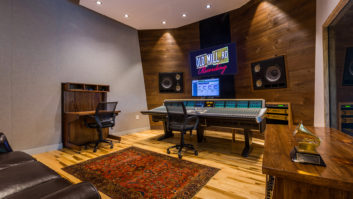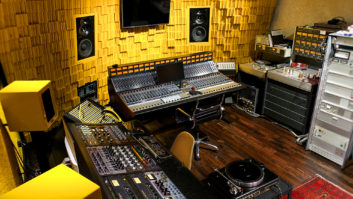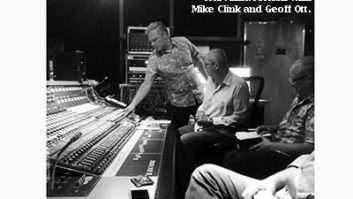by Janice Brown
New York, NY–DJ/musician Derek Ferguson’s concept for Integrated Studios may seem a bit Utopian to the more business-minded. Rather than focusing solely on investment return, he and his brother created this multimedia production facility as a place in which seminal art could be made; every room, every tool, and every person involved in Integrated is relevant to achieving this objective. And because this facility was designed (and later refined) with such care, it only makes sense that the artists working inside would be inspired to make great art.
In the beginning, Derek and Eliot Ferguson purchased the 5-story building on cobblestone-paved Washington Street in lower Manhattan and set it up to accommodate audio and video, animation and graphics production work. The fourth floor was the designated audio floor and with both brothers being musicians–Derek a DJ and producer/songwriter and Eliot a songwriter and drummer in gypsy punk band Gogol Bordello–they originally intended to keep the studios private. Working with an eccentric designer to realize his aesthetic vision for the complex, Derek admits with a wink, “I’m an artist at heart, and in some early decisions I incorporated elements that were probably more stylish than substantive.”
Integrated’s chief engineer and in-house producer Carlos Bess (left) and chief tech Kevan Griffin The result of the original designs is a stunning and very unique and ergonomic feeling facility. And, very early on, Integrated became like a work of art to labor over and perfect. The terrorist attacks on the World Trade Center located blocks away played a hand in that. “We bought the place shortly before 9/11, and afterwards we had 18 months of dealing with a “frozen zone.” It was very difficult, financially and emotionally, to keep it going in the midst of chaos,” shares Derek. “You hope in business, as you hope in life, that you’ll eventually make some money and history will then record your work as a good thing. Life guarantees a challenge, and that was a particular one for us. But, for an artist, the very act of creation is a leap of faith that we take in order to make something that transcends our lives. That’s what art is, and that’s why people sacrifice and starve to create something that will be here when they’re gone. It’s less about profit, and more about meaning.”
Perhaps such a major obstacle put things into a different perspective, or maybe the Fergusons would have always held this building they’d designed to such high standards; either way, Derek decided to take the facility to the next level, in preparation for opening the studios at least half of the time to outside bookings. An iso booth with full-length view into the mix room”I started listening more to what my audio colleagues were telling me–that despite all of our analog outboard gear, to get the authentic sound we wanted we needed to bring in a real board to replace the digital one we were using and make a few acoustic changes. So we went and got the best people we could find to do the job right.” Here, he benefited from the combined expertise of studio designer/acoustician John Storyk and David Malekpour, founder of Professional Audio Design (PAD).
“In Storyk and Malekpour, I found guys who were doing things on the level I wanted,” notes Ferguson. “I understood that we really couldn’t take shortcuts in their acoustic designs, nor did I want to. I knew I wanted a world-class mixing room, and they knew the amount of space I had in which to do it. I simply asked, can you make it happen? After some serious head scratching, they determined they could, and then we got down to work.”
The audio floor was redesigned with the new mandate in mind, though the basic configuration stayed the same: a writing/recording studio, an “Aretha-sized” vocal booth, tracking room, sleek lounge, mastering suite, and the all important mix studio. During a party held the first night of the AES Convention in October, 2005, Les Paul came to check out the new mix room. Pictured in front of the SSL 9000 J console and custom orange Augspergers are (l-r): John Storyk, Derek Ferguson, Les Paul, and David Malekpour.All of the rooms benefitted from Storyk’s magical acoustic design and treatment touches, and from Malekpour’s cool assessment of what equipment was needed to fill any gaps in an already formidable audio arsenal. Under expert direction, the Technical Structures construction team had the mix room ready in time for Integrated to host the Opening Party for AES in October 2005. Audio experts, including notables Eddie Kramer and Les Paul, were among those who marveled at the mix room’s sound while catching a preview of unreleased material from in-house producers and artists.
In this aesthetically exhilarating environment, the mix room still stands out as the flagship space. With its impressive, spaceship-like control room featuring western and southern exposures and affording vistas of both the Hudson River and of downtown Manhattan, one can hardly think of a better place to spend the hours fine tuning a mix.
Positioned behind the PAD sourced SSL 9000 J Console, the custom orange Augspurgers in this white and airy control room immediately catch your eye; as Genelec 5.1 monitors surround you, a quick perusal of the room reveals other new tools which legitimize the “world-class” moniker: Lexicon 480L and PCM 42s, Urei 1178 and 1176s, Teletronix LA2As, Manley Massive Passive and Vari-Mu, Thermionic Culture Phoenix, and Empirical Labs Fatso and Distressors are among the outboard tools, and a newly acquired Studer A-827 24-track 2″ machine sits behind clear isolating glass in the rear of the room.
Ferguson plans to book the entire floor out for each session, and hopes to keep a ratio of about 50-50 outside bookings to internal artists. Integrated’s chief engineer, Carlos Bess, is a veteran mixer and producer, and has just finished his own album to be released by Sony/BMG. With his wide range of skills and interests, Bess exemplifies the typical Integrated employee. “It’s so cool here because I can work in several different creative modes at once,” says Bess. “One day I can be programming, another I can be mixing, and another day I can use the sound stage to record a live band or do web design.”
One of the most interesting aspects of Integrated’s audio floor is its openness. Although there are various doors off the main hallway, each room shares large isolating windows that can be covered by blinds, but can also be opened up for sightlines throughout the floor. The mastering suite is the only portion of the floor sectioned off, and booked on the daily by in-house mastering engineer Larry Lachmann. When you book the audio floor at Integrated, you also get the 6th floor roof deck, complete with screened-in hot tub, shower and 50″ plasma. Situated only a block from the river in a quiet yet accessible part of TriBeCa, incredible views add to the feeling of serenity and remove from the hustle of city life.
With Derek’s full catwalk-hung DJ booth floating above, Integrated’s soundstage can be transformed from rehearsal/live room to private club, as in the case of the AES party, when DJ Todd Terry (an Integrated collaborator) headlined a crew that kept the floor filled to the wee hours. Tielines enable recording from anywhere in the building, and recent acoustic modifications make the soundstage a fitting tracking room for full bands and small orchestral sessions. The third floor of Integrated houses video editing and production suites, along with administrative offices, and the second floor in front of the soundstage is a lounge/green room that overlooks it, a conference room with videoconferencing capabilities and a hair and makeup room. Integrated is truly a soup-to-nuts design.
“The relationships I’m most interested in forming are with people going up the scale, pre-tipping point,” says Ferguson. “Obviously we’ve worked and continue to work with big companies like MTV, Ogilvy, the major labels, etc., but working with smaller, independent companies and helping them deliver a top-tier product also gives me a very high degree of satisfaction. So, to the extent that we can subsidize some of the more artistic projects with some of the more commercial ones, we will. We provide a boutique facility for a select clientele, with individualized service and equipment designed to maximize workflow, all within a salon atmosphere that cultivates the fluid exchange of ideas among fellow artists. But make no mistake: we can strategize large sessions here too, from writing and pre-production through to audio/video post production and mastering, we can handle it all.”
Since NYC-based Gogol Bordello has been gaining popularity, Eliot’s been touring and recording with the band full-time, and Derek’s been running the show at Integrated. Since creating important and socially responsible art is always at the center of Integrated’s mission, Derek will be somewhat selective in the kinds of projects he admits, but he’s not immune to commercial realities. “As a business we have to be fiscally as well as socially responsible. I want to make art that’s cool, that’s important, and that motivates us. But, I also want to eat. So, you have to find a balance. Pop music, commercials, yeah, we do those things, and we respect all the professionals involved in those projects; it’s hard work to do it right.”
So the good ship Integrated continues to sail for Utopian horizons, albeit with some corporate wind in its sails. “Finding the right mix of art and commerce is the real challenge, and doing work that you’re proud of on all levels is the ultimate goal; being the flavor of the month and using your credibility to promote some “branding event” isn’t. Platinum records are nice, but classic records have a greater value because they’re timeless.” A giant cruise ship drifts past the mix room’s picture window. Light filters from the setting sun, casting a golden glow in the room. Right here, right now, the worlds of art and commerce look pretty comfortable together. “Besides,” he says with sly smile, “when we get sick of this view, we’ll just sell the building and move on. That’s the best way to sell out.”
Integrated Studios
www.integratedstudios.com





